Team autographed baseballs, especially those signed by wartime service players, are invaluable treasures to add to a collection of baseball militaria. Our collection includes several balls with signatures penned by teams including the 1943 and 1944 Norfolk Naval Training Station Bluejackets, the 1943 Pearl Harbor Submarine Base Dolphins, the 1945 Hickam Bombers, and even a wartime armed forces softball signed by Hall of Famers Bill Dickey and Billy Herman. Most of these examples showcase dark and crisp pen strokes that are legible and easy to identify. A recent addition to our collection is one that is decidedly unique due to what we suspect to be detrimental environmental exposure.
Devoid of all manufacturers’ markings and absent signs to properly date the ball, coupled with its condition, we faced no competition in pursuit of the item as it was listed. The auction listing’s photographs provided several perspectives showing many familiar names; however, nearly every autograph was seemingly inverted in its appearance. It was difficult to ascertain what happened to the ball, but it was quite obvious that some sort of decay had impacted each of the signatures encircling the horsehide.
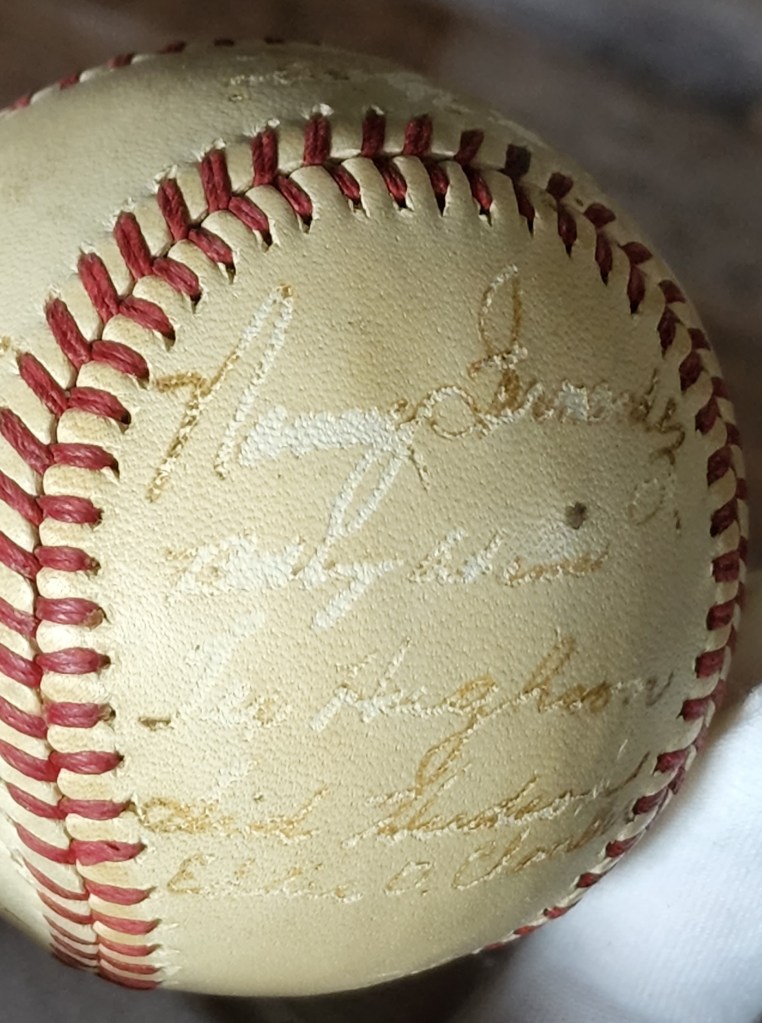
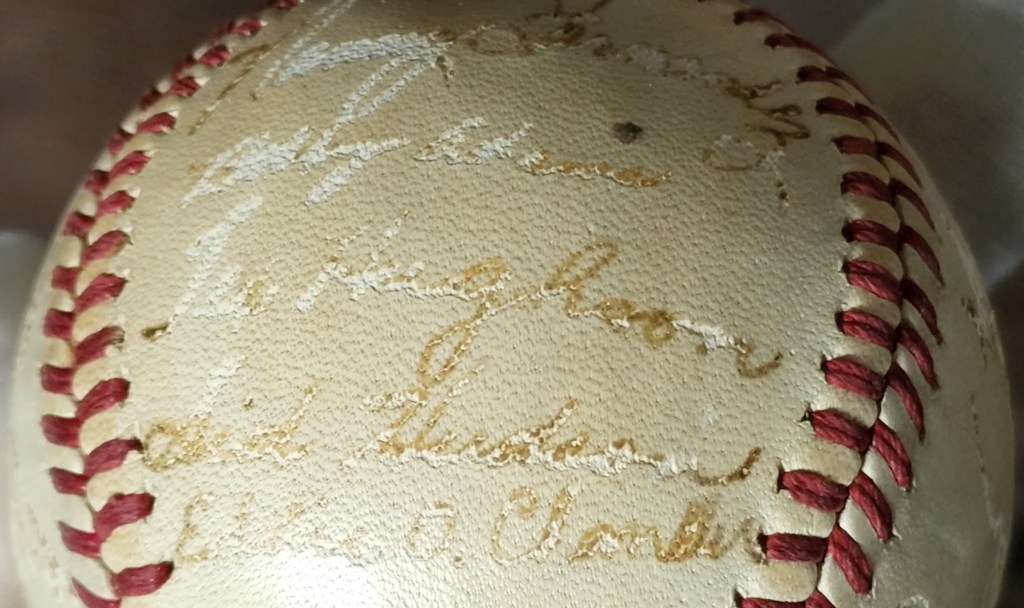
Due to the condition, the listing had a reasonably low price. Understanding that the risk was commensurate with our offer, the acquisition seemed to be worth the price if only to get the opportunity to examine the autographed baseball more closely. Recognizing most of the visible signatures in the photos, there was a good chance that this ball was signed in the weeks before the Japanese surrender.
More than 500 ballplayers with major league experience served in the armed forces during World War II and nearly ten times that number of minor leaguers handed in their flannels to join the rank and file of the Army, Navy, Marine Corps and Coast Guard during the national emergency. By the summer of 1945, the Japanese forces were pushed back towards the homeland and off the islands they held in the previous years. The Army and Navy had significant bases of operations established on Guam, Saipan and Tinian and were using these locations to bring the fight to the enemy’s homeland. To boost troop morale, many of the game’s biggest names were serving and playing baseball on the islands. The Navy’s Pacific Tour in the spring sent teams representing the Third and Fifth Fleets from island to island, playing before massive crowds of airman, soldiers, Marines, and sailors. At the conclusion of the Navy’s baseball tour, the players were dispersed to commands throughout the Marianas.

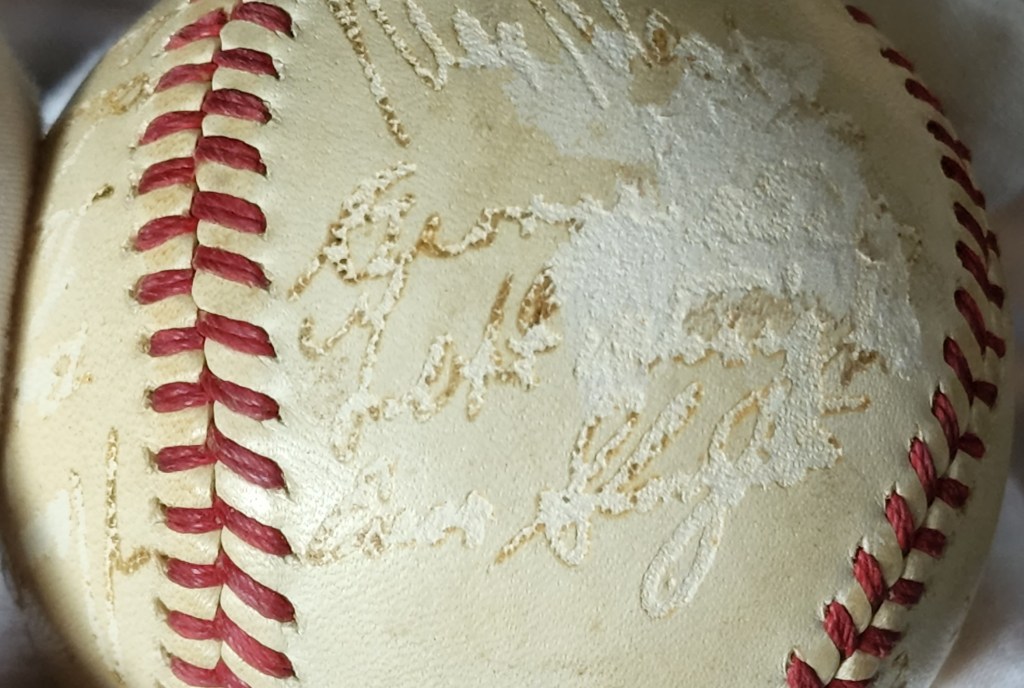
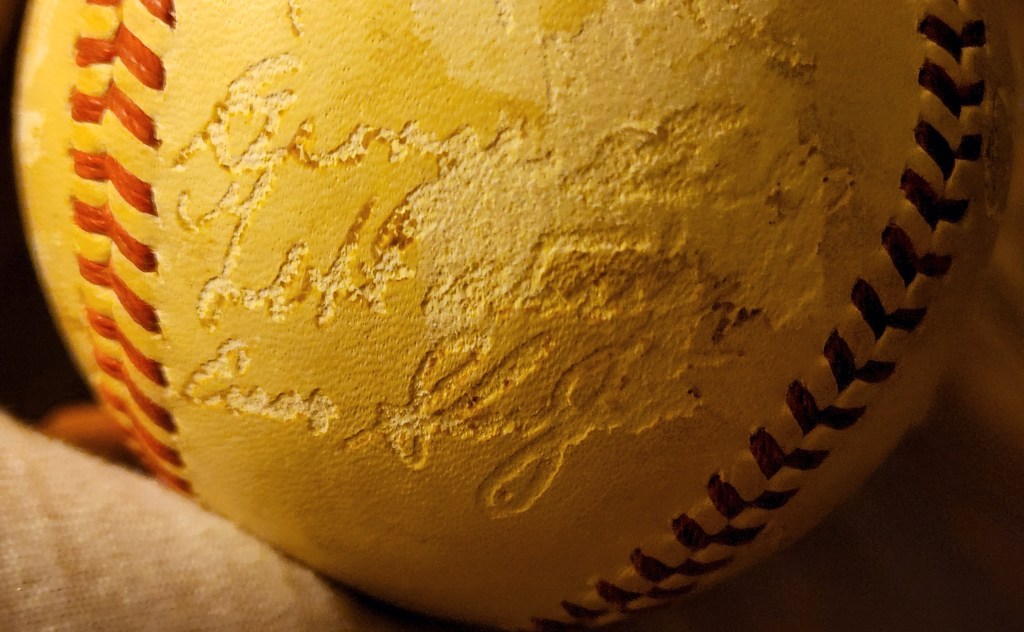
Following the Navy’s lead, the Army assembled three teams representing the major Army Air Forces commands – the 313th, 58th and 73rd bombardment wings of the 20th and 21st Bomber Commands, headquartered on Guam, Saipan, and Tinian. The rosters of the three squads were filled with men who, prior to their entry into the Army, were stars of the game in the major and minor leagues. They were led by managers Lew Riggs (313th “Flyers), George “Birdie” Tebbetts (58th “Wingmen) and Colonel “Buster” Mills (73rd “Bombers”).
Our odd, autographed baseball arrived and upon closer examination, it was clear that some sort of reaction between the ink in the signatures and the horsehide resulted in a weakening of the surface and subsequent erosion, which in turn resulted in ghost indentations of the original autographs. In some areas, faded ink remained intact but overall, the autographs had the appearance of impressions. Regardless of the deterioration, the autographs were still legible and we were able to identify all but one of the 23 names encircling the ball.
Of the 50-plus players distributed among the three U.S. Army Air Forces ball teams, Joe Gordon and Enos Slaughter were future Baseball Hall of Fame enshrinees while several more were All-Stars. Unlike today’s inherent wall of separation between players and fans, the armed forces ballplayers made efforts to be among their comrades, working alongside them, dining with them and even sleeping in the same quarters with them. They were readily available for GIs seeking autographs. It is common to find signed programs, scorecards, photos, bats and baseballs among GIs’ medals, uniforms, and other wartime artifacts. While not as valuable as a World Series team-signed baseball or a major league game program autographed by a legend, service team-signed artifacts provide a unique prospective on baseball and World War II history.


The principal islands of the Marianas were home to the 20th Air Force’s long-range bombers that conducted incessant air strikes on the Japanese homeland. Countless Boeing B-29 Super Fortresses sortied from the islands to Japanese military targets some 1,500 miles away, encountering flak and enemy fighter resistance and suffering losses or returning to their bases with heavy damage and wounded or killed crewmen. The operational pace and the casualties exacted a heavy toll on the morale of airmen and ground support personnel. Watching their heroes playing a baseball game during downtime gave the men respite from the horrors and losses of continuous combat and support operations.
As stated earlier, the United States Strategic Air Forces in the Pacific (USASTAF), based on Guam, Saipan, and Tinian, consisted of the 20th and 21st Bomber Commands with three bombardment wings – the 58th and 73rd (in the 20th) and the 313th (in the 21st). Each wing was comprised of multiple bombardment groups (40th, 444th, 462nd and 468th in the 58th; the 497th, 498th, 499th and 500th in the 73rd; 6th, 9th, 504th, 505th, 509th and 383rd in the 313th) with roughly four bombardment squadrons in each group. For these two bomber commands, there were approximately 30,000 men, not to mention the additional Army, Navy and Marine Corps personnel also stationed on the islands. Each of the baseball teams represented more than 10,000 Air Forces personnel when they took the field.
313th Bombardment Wing “Flyers”
| Rank | Name | Position | Former |
| Rinaldo “Rugger” Ardizoia | P | Kansas City (AA) | |
| Eddie Chandler | P | Pocatello | |
| Carl DeRose | P | Amsterdam | |
| Corp. | Froilan “Nanny” Fernandez | SS | Braves |
| Stan Goletz | P | White Sox | |
| Johnny “Swede” Jensen | LF | San Diego (PCL) | |
| Walter “Wally” Judnich | RF | Browns | |
| Bill Leonard | CF | ||
| Don Looser | P | ||
| Al Olsen | P | San Diego (PCL) | |
| Lewis S. Riggs | 3B/Mgr. | Dodgers | |
| Bull Storie | CF | ||
| Johnny Sturm | 1B | Yankees | |
| Max West | CF | Braves |
58th Bombardment Wing “Wingmen”
| Rank | Name | Position | Former |
| Bob “Bobby” Adams | 2B | Syracuse (IL) | |
| Al “Chubby” Dean | P | Indians | |
| Tom Gabrielli | C | Pirates | |
| Corp. | George Gill | P | Tigers/Browns |
| Joe Gordon | SS | Yankees | |
| Capt. | Billy Hitchcock | 3B | Tigers |
| Edwin “Ed” Kowalski | P | Appleton (WISL) | |
| Al Lang | LF | Reds | |
| Don Lang | OF | Kansas City (AA) | |
| Pete Layden | OF | collegiate | |
| Arthur “Art” Lilly | IF | Hollywood (PCL) | |
| Joe Marty | OF | Phillies | |
| Roy Pitter | P | Binghamton (EL) | |
| Howie Pollet | P | Cardinals | |
| T/Sgt. | Enos “Country” Slaughter | OF | Cardinals |
| Chuck Stevens | 1B | Browns | |
| Johnny Sturm | 1B | Yankees | |
| Capt. | George “Birdie” Tebbetts | C/Mgr. | Tigers |
| Vic Wertz | CF | Tigers |
73rd Bombardment Wing “Bombers”
| Rank | Name | Position | Former |
| Bob Dillinger | 3B | Toledo (AA) | |
| Bill Dudley | Utility | collegiate | |
| S/Sgt. | Ferris Fain | 1B | San Francisco (PCL) |
| Sid Hudson | P | Senators | |
| Tex Hughson | P | Red Sox | |
| Frank Kahn | P | Dodgers prospect | |
| Ralph Lamson | IF | Milwaukee (AA) | |
| Al Lein | P | San Francisco (PCL) | |
| Sgt. | Dario Lodigiani | IF | White Sox |
| John “Johnny” Mazur | C | Texarkana (EXTL) | |
| Myron “Mike” McCormick | OF | Reds | |
| Colonel “Buster” Mills | OF/Mgr. | Indians | |
| Sgt. | Stan Rojek | SS | Dodgers |
| Bill Schmidt | P | Sacramento (PCL) | |
| Charlie Silvera | C | Wellsville (PONY) | |
| Taft Wright | OF | White Sox |
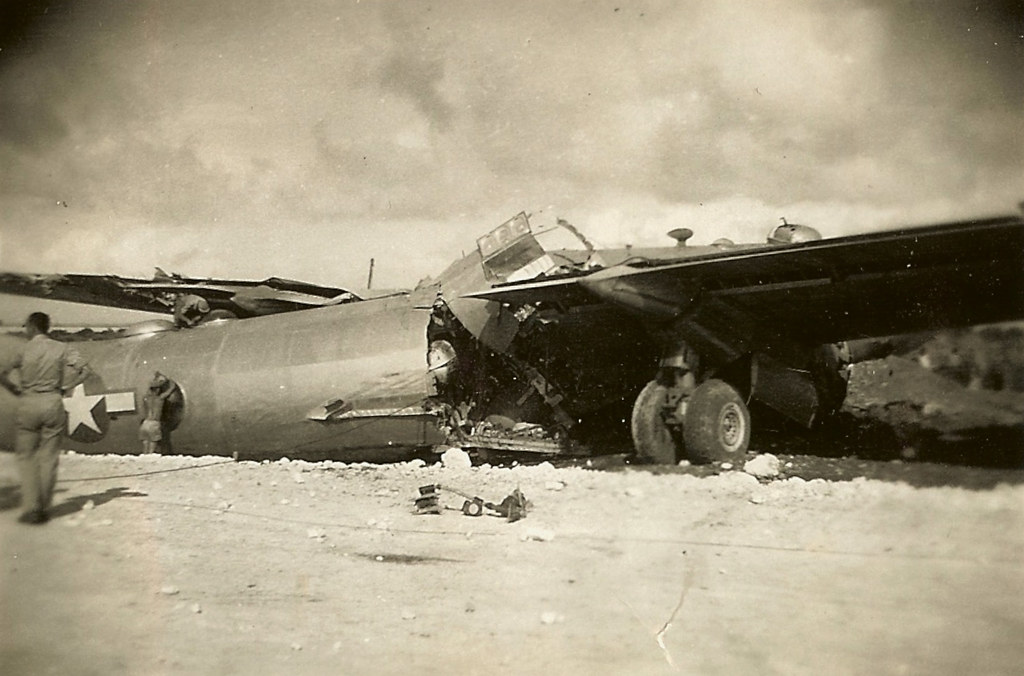
The USAAF Marianas baseball competition was held in a three-team round-robin fashion with the tournament commencing on July 27, 1945. Birdie Tebbetts’ 58th Wingmen took on Buster Mills’ 73rd Bombers. The 1944 Hawaiian League batting champ from the 7th AAF team, Ferris Fain, secured the win for Tebbetts’ Bombers by hitting a game-winning solo home run in the bottom of the ninth inning. As the tournament progressed throughout August and into September, the operational pace of the B-29 missions over Japan with the low-level bombing runs continued. It was not uncommon for a game to be played while the aircraft were away on a mission. The ball game offered a few hours of relief from the tension and stress as the men on the ground awaited the return of squadron aircraft during the 15+-hour missions, hoping that all planes would return safely. Hours after the final out of a game, as the very heavy bombers were returning, ground personnel would count the number of aircraft and hope that those that did make it back had safely landed despite any damage sustained. The landings were anything but guaranteed as some B-29s overshot runways and ditched into the sea, crashed, or burst into flames on the Guam, Saipan, and Tinian airstrips.

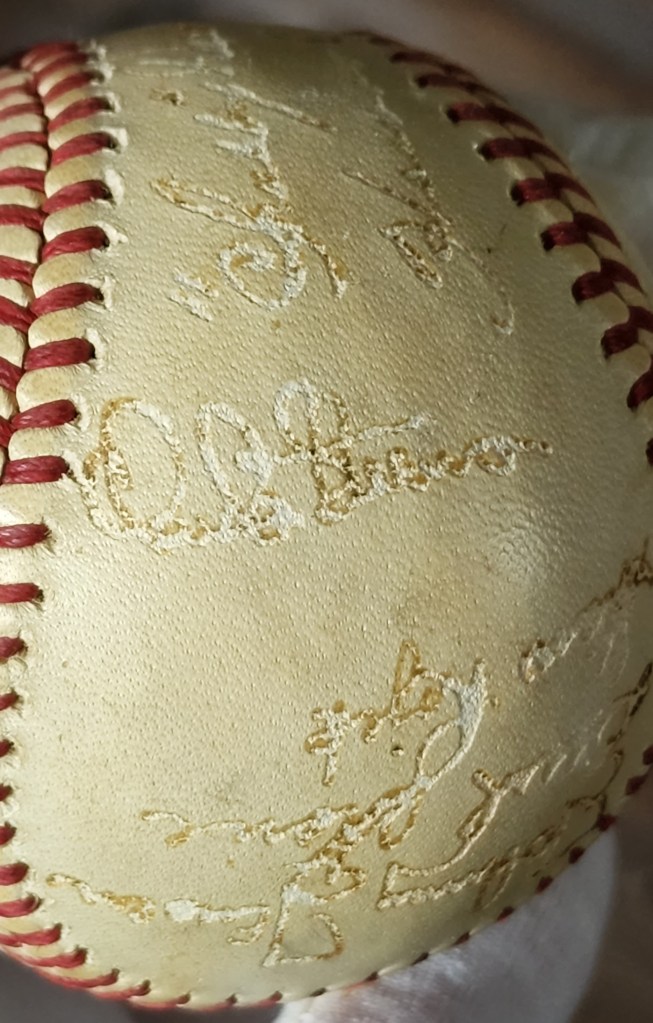

Lew Riggs {Chevrons and Diamonds Collections).
The three teams played 27 games with their total cumulative spectators numbering more than 180,000. There were plenty of opportunities for GIs serving on the islands to obtain autographs. With 24 signatures from players on the 58th (9), 73rd (4) and 313th (9) Wings, it is apparent that the GI was working diligently to get the ball covered with ink from as many of the 50 players as possible.


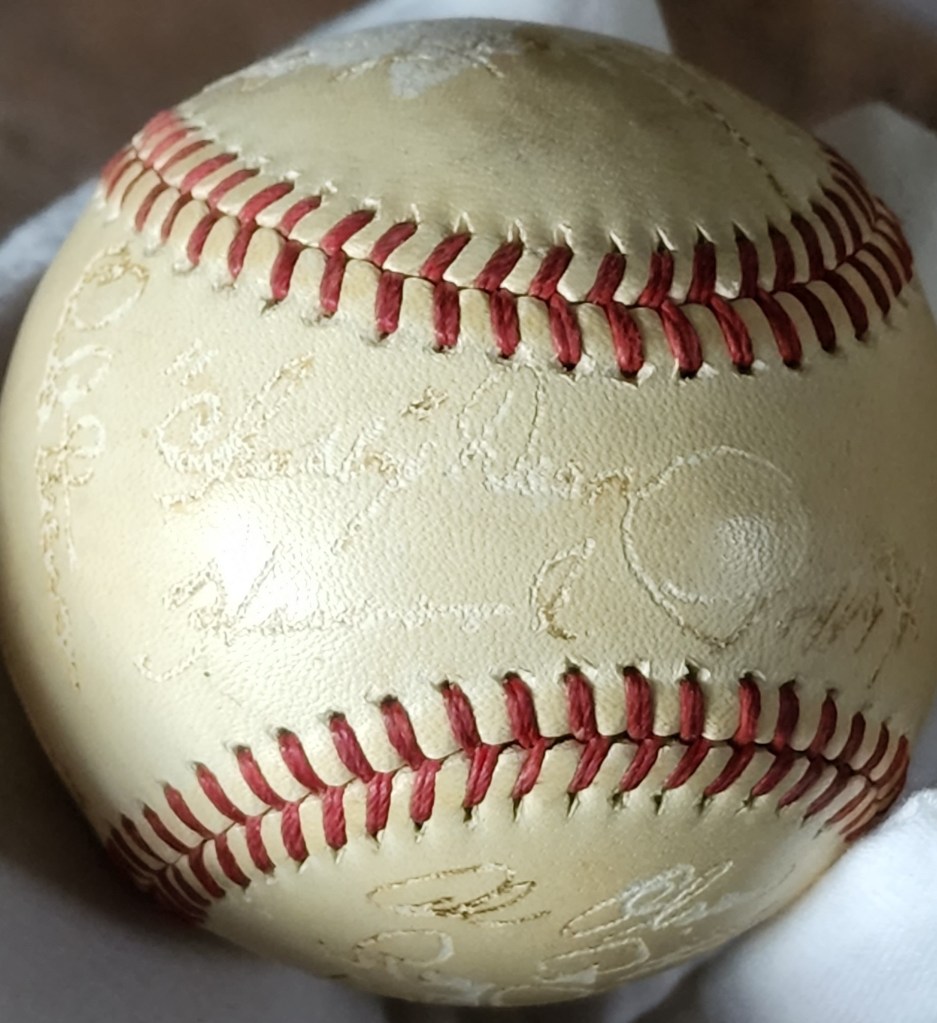
Of the two future Cooperstown enshrinees, Joe Gordon and Enos Slaughter, the latter’s name graces our ball, joined by his former Cardinals teammate, pitcher Howie Pollet. Unfortunately, both of their autographs, like most of the others on the ball, have oddly deteriorated. Regardless of the condition, the signatures are still recognizable and the ball is decidedly a conversation piece. To prevent continued decay, the ball is stored away from the environmental elements that likely contributed to the demise of the signatures.
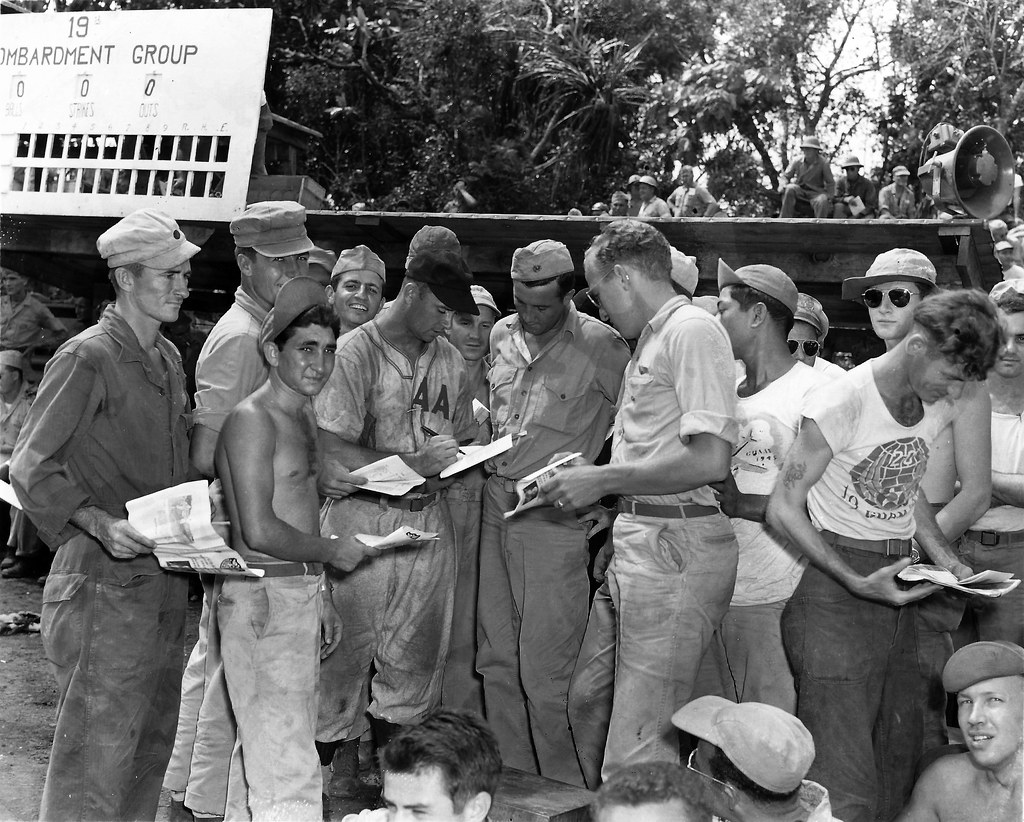
It is not difficult to imagine the USAAF ballplayers encircled by GI autograph seekers after a game. Following a long day of performing bomber engine maintenance and refueling and rearming aircraft or the emotionally draining task of cleaning blood from wounded or killed airmen, the simple pleasure of obtaining signatures from star baseball players at a game helped to take the men’s minds off the hardships of their jobs. Considering the arduous duty conditions in the Marianas and despite the degradation of the autographs, this ball is a welcome addition to the Chevrons and Diamonds Collection.
See also:


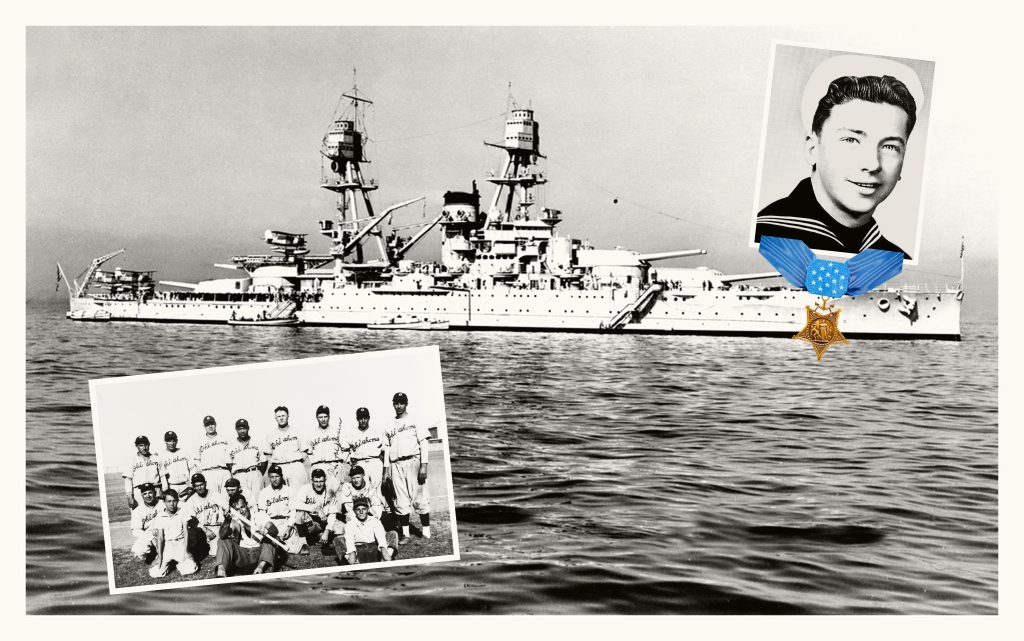
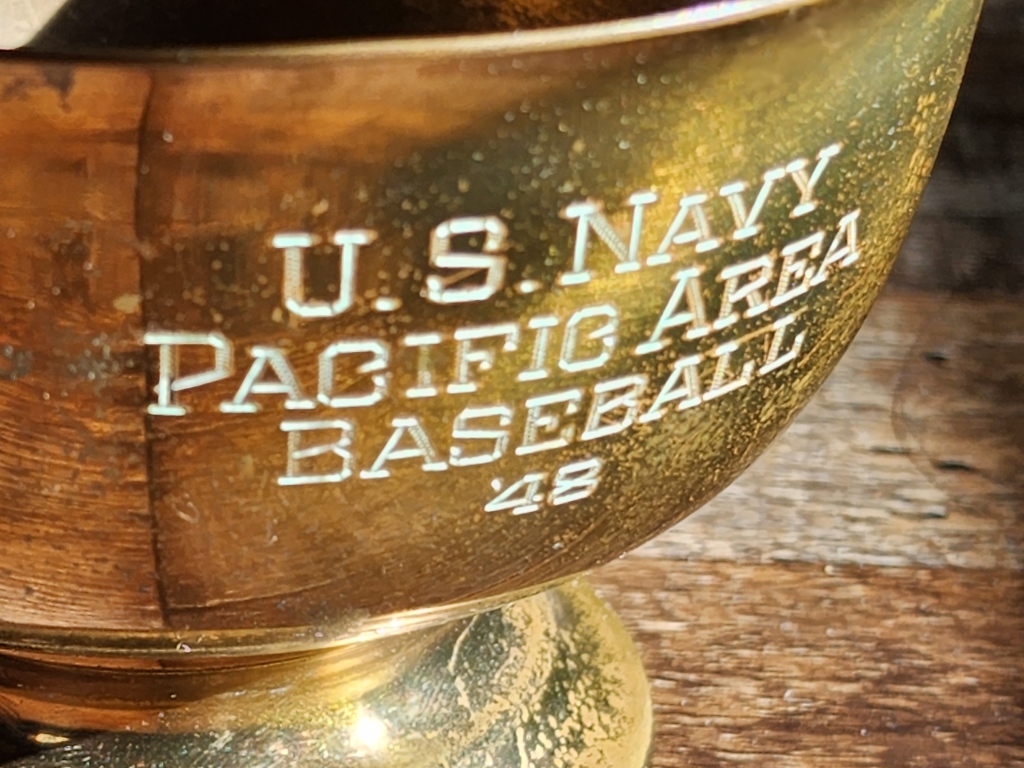

Leave a comment